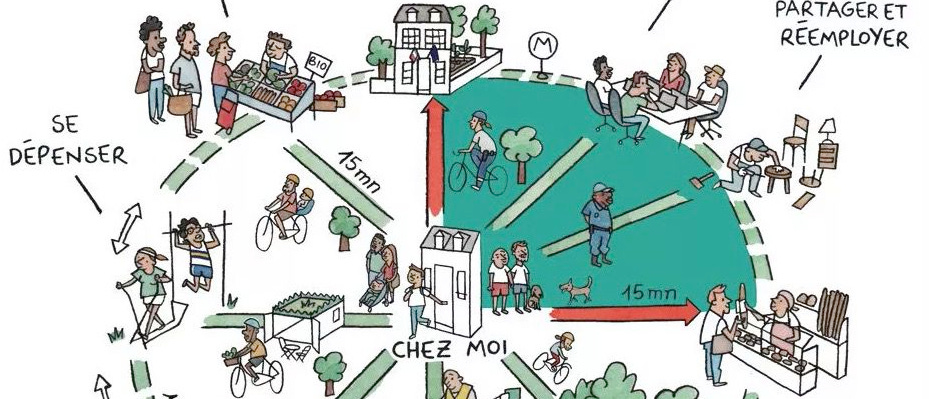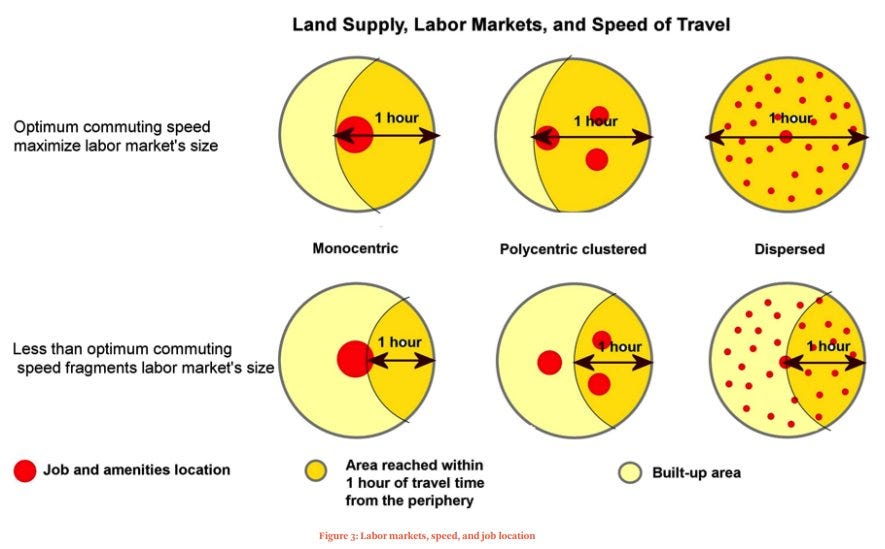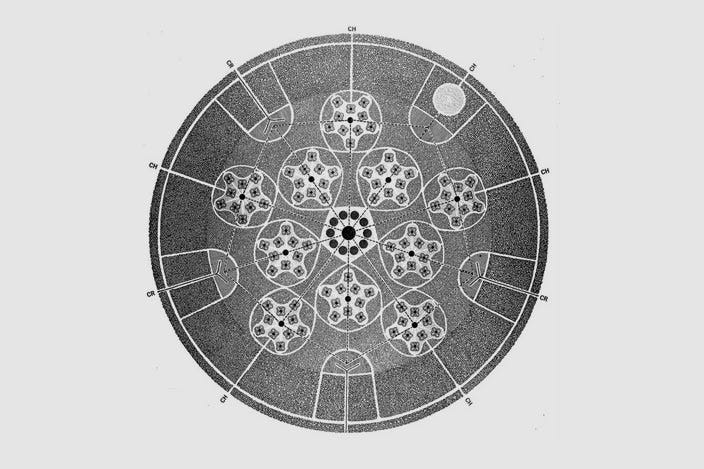
The 15-minute city has been the talk of urban planning twitter, since Paris’ Anne Hidalgo ran her winning mayoral re-election campaign on shifting the way we go about urban life. At its core this concept contains an old dilemma regarding the efficient organization of cities: monocentric vs. polycentric. Monocentrism is historically represented by Johann Heinrich von Thünen, whom in 1826 proposed a highly simplified rent-driven model of land-use organization: a concentric structure with the city at the center surrounded by progressively wider radial layers used for husbandry, energy & agriculture. Simplified models however - despite thoroughly appealing to our attention spans - never reflect reality. Similarly in its typical representation, the polycentric city contains a number of geographically fragmented centralities. The ultimate aim of polycentrism is to break the central hub paradigm, and give citizens access to more services closer to their residence.
A 15-minute metropolis sounds awesome - except that it quickly becomes a small insulated town if taken literally. The diversity of amenities afforded to cities stems from the ability to leverage density. The number of businesses grows linearly to population - typically 1 new business for every 22 new people. Diversity however - that niche Asian restaurant or specialized Rubik’s cube shop - grows more modestly: a doubling of establishments brings about only a 5% increase in novel ventures. Living in a 15-minute city should not mean lack of access to highly-specialized establishments. It should be interpreted as an attempt to decentralize routine services and provide basic commercial necessities closer to the place of residence.

Most importantly however cities serve as highly efficient labor markets - they connect a varied and interdependent labor force to diverse work opportunities. Most of commuting and corollary congestion happens at rush hour: the time when people travel from home to work and vice versa. In the above diagram from Order Without Design, Marie-Agnes & Alain Bertaud skillfully illustrates the key connection between home, work/entertainment and speed of travel. The 15-minute city should attempt to minimize inconvenient & needless travel, while offering speedy access to jobs and amenities regardless of the place of residence. The traditional central business district is somewhat efficient in this sense; polycentric planning needs to figure out how it can keep the efficiencies of a central business district while offering the comfort of a walkable neighborhood. Even if all super-creatives work from home, that still leaves 88% of the labor force which needs to move around. Swift mobility will be a key aspect of urban living for the foreseeable future and a crucial determinant to the success of polycentric cities.

One Book
Triumph of the City: How Our Greatest Invention Makes Us Richer, Smarter, Greener, Healthier and Happier by Edward L. Glaeser
Triumph of the city is a fantastic trip through cities and their importance to modern civilization. The main issues that stand out, regard the paramount impact that education and diversity have in fostering successful citizens for the future. Glaeser thoughtfully argues that growing cities are in dire need of residential development; obstacles to such undertakings seem to be harmful not only to the city itself but more importantly to the poorest inhabitants of metropolitan areas, whom are also the engine that drives cities to growth and efficiency.
Three Links
Complexity Scientist Beats Traffic Jams Through Adaptation by Rodrigo Pérez Ortega
How letting mobility systems self-organize works better than controlling them.
An Asymmetric Landscape: The Shapes of Blue & Red News by Anthony Koithra
Visualizing the political shape of news networks.
How Cities are Perceived by Tourists and Locals Through Maps by Romullo Barato
How routine and path-dependencies shape the way we experience cities.
Five Tweets
And the last phenomenon recorded for me is an ant mill.
— bioloco (@biolocousb) August 23, 2020
This happen when some ants lost track to it colony and follow other ants in a rotating circle of death. 😱🐜☠️
I dont know what is genus or specie from this ants. #InverteFest @InverteFest pic.twitter.com/ocysJ3jlHf
We're heading into what geologists call an 'ocean anoxic event' (OAE). Unlike the atmosphere, which heats from the bottom up and stays well mixed, the ocean heats from the top down: more heat = less mixing. OAEs turn the seas into planet-wide dead zone. https://t.co/w9Wj6cdYcB
— Mark Lynas (@mark_lynas) September 29, 2020
Resharing this series of paths created by 800 unmanned bicycles being pushed until they fall over. Science is beautiful. Source: https://t.co/Y8mXeUgN4o pic.twitter.com/2ujnkT3taP
— Simon Kuestenmacher (@simongerman600) September 28, 2020
Not CGI.
— Brian Roemmele (@BrianRoemmele) April 26, 2020
The Grand Lisboa Hotel, Macau. pic.twitter.com/sKOjjkoi0Y
Infosec tweet of the month https://t.co/ccBqoYDyki
— @mikko (@mikko) September 30, 2020
This was the second issue of Think Think Think - a periodic newsletter by Joni Baboci on cities, science and complexity. If you liked it why not subscribe?
